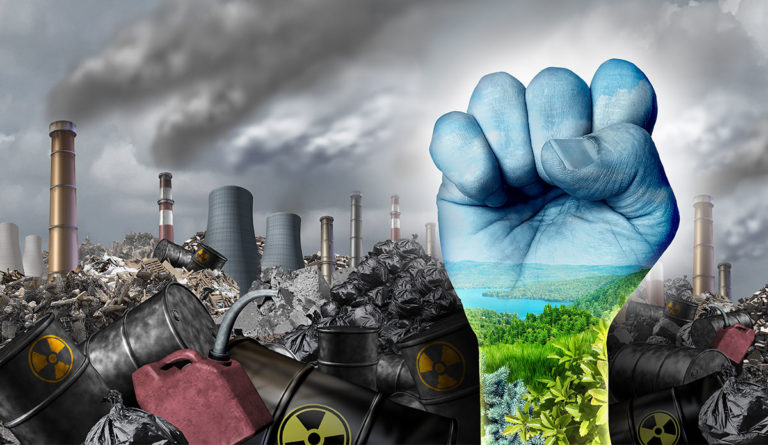Environmental Justice Finally Legitimized in Massachusetts
The authors highlight recently passed Massachusetts environmental justice legislation and its implications.

Read Time: 4 minutes
Published:
Laws to protect vulnerable communities from environmental degradation are historically hard to pass. However, deferment turned into progress this past spring when Massachusetts was able to ratify one such law, decades in the making.
On March 26, 2021 Governor Charlie Baker took action to combat environmental injustice in Massachusetts by signing a revolutionary bill into law: “An Act Creating a Next-Generation Roadmap for Massachusetts Climate Policy” (colloquially known as the “2050 Roadmap Bill”). The primary goal of the bill is to create a net-zero greenhouse gas emission limit in Massachusetts by 2050. Yet the environmental justice amendment is what makes this bill especially revolutionary, as it outlines and defines certain precepts of environmental justice principles for the state.
Environmental justice, as defined by the Environmental Protection Agency, is “the fair treatment and meaningful involvement of all people regardless of race, color, national origin, or income with respect to the development, implementation and enforcement of environmental laws, regulations and policies.” The 2050 Roadmap Bill marks the first time an environmental justice law has been codified into Massachusetts state law. This is important because now it will be within the state’s purview to ensure lower income and racial minority groups do not disproportionately suffer the effects of environmental pollution, degradation, or abuse.
There have been attempts to tackle environmental injustice in Massachusetts in the past. One example is the 2002 Environmental Justice Policy issued by the Executive Office of Environmental Affairs and former Governor Deval Patrick’s 2014 Executive Order 552. But the environmental justice language of each attempt was never codified into state law books, thus making it vulnerable to changes in administrations over the years.
For example, the 2002 Environmental Justice Policy defined environmental justice populations as “high-minority/low-income neighborhoods in Massachusetts where the residents are most at risk of being unaware of or unable to participate in environmental decision-making.” The 2050 Roadmap Bill provides a new definition of what constitutes an environmental justice community and raises the standards to decrease the number of census blocks classified as environmental justice neighborhoods in Massachusetts. This allows the state to focus more resources on the most overburdened communities.
The hope is to change the past criticisms about the lack of community involvement in how the state has reviewed and approved development, infrastructure, and energy projects in environmental justice communities.
The 2050 Roadmap Bill also creates new standards for public participation in the decision-making process and establishes an environmental justice advisory council. The hope is to change the past criticisms about the lack of community involvement in how the state has reviewed and approved development, infrastructure, and energy projects in environmental justice communities.
Lastly, the bill changes how the state calculates the environmental impacts of any given project proposal. In the past, agencies assessed a project’s potential for air, water or soil pollution separately. Under the new law, agencies will be required to consider cumulative impacts, or the total burden of pollution, from a given project in relation to already-existing pollution in that neighborhood.
These last two tenets of the environmental justice amendment would have been especially important in the recent struggle between Eversource and the state-designated environmental justice communities of East Boston and Chelsea. For years these communities have been fighting against the installation of an Eversource electrical substation. Activists and local leaders have argued that residents (especially those who do not speak English) were largely excluded from the early discussions with Eversource back in 2014. And their concerns have been ignored since then.
The primary concern is that Eversource failed to consider potential safety concerns of the substation on the surrounding community. For example, the planned location of the substation is near Chelsea Creek in an area prone to flooding in heavy storms. Chelsea Creek is projected to flood more frequently, and to a greater degree, in the future due to climate change and rising sea levels. Additionally, substations are extremely flammable, and tanks of jet fuel are stored for Logan Airport a few hundred feet away from Eversource’s proposed location. Parents and families are especially concerned about the substation’s proximity to a local park, situated in a densely populated neighborhood.
The environmental justice amendment of the 2050 Roadmap Bill could have protected this community and prevented the project’s approval. First, it would have mandated that the environmental impacts of the project be calculated together, not apart. And second, meetings would have been made public to the community from the start, with translation services provided.
Although the fight in East Boston isn’t over, Massachusetts environmental justice activists point to this situation as a key reason why a bill like this is necessary and revolutionary. It gives them hope that, in the future, a scenario like this won’t ever be allowed to happen again in the Commonwealth.




